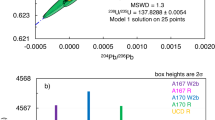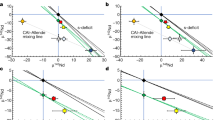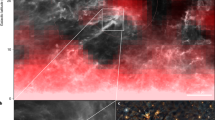Abstract
Several now-extinct radionuclides are believed to have been present in the early Solar System1 and have been used to infer the time-scales for various processes during its formation. However, the precise interpretation of the Chronometric significance of an extinct nuclide depends on whether isotopic heterogeneities exist in that nuclide and/or in its daughter product. This is probable because such heterogeneities have already been found in many elements. Birck and Allègre2 have recently reported data suggesting the presence of a new extinct nuclide, 53Mn (mean life τ=5 Myr). In this letter I show that their data are inconsistent with the prediction of a single-stage model in which both Mn and its daughter element Cr were isotopically homogeneous. I also explore the virtues and consequences of the three alternative interpretations of the inconsistency: (1) the host material has experienced multiple-stage evolution, (2) 53Mn was heterogeneously distributed, or (3) 53Cr has intrinsic anomalies.
This is a preview of subscription content, access via your institution
Access options
Subscribe to this journal
Receive 51 print issues and online access
$199.00 per year
only $3.90 per issue
Buy this article
- Purchase on Springer Link
- Instant access to full article PDF
Prices may be subject to local taxes which are calculated during checkout
Similar content being viewed by others
References
Wasserburg, G. J. Proto-stars and Planets II (ed Black, D. C. & Matthews, M. S.) 703–707 (Univ. Arizona Press, 1985)
Birck, J. L. & Allègre, C. J. Geophys. Res. Lett. 12, 745–748 (1985).
Lee, T., Papanastassiou, D. A. & Wasserburg, G. J. Geophys. Res. Lett. 3, 109–112 (1976)
Nitoh, O., Kamata, M. & Honda, M. Abstr. Vol. 4th Int. Conf. Geochron., Snowmass, Colorado, 308–310 (1978).
Lee, T. & Tera, F. Abstr. Vol. 5th Int. Conf. Geochron. Nikko, Japan, 212–213 (1982).
Lee, T. & Tera, F. Geochim. cosmochim. Acta 50, 199–206 (1986).
Birck, J. L. & Allègre, C. J. Geophys. Res. Lett. 11, 943–946 (1984).
Papanastassiou, D. A., Zyskind, J. L., Ngo, H. H. & Wasserburg, G. J. Meteoritics 20 (in the press).
Papanastassiou, D. A., Astrophys. J. Lett. (in the press).
Anders, E. & Ebihara, M. Geochim. cosmochim. Acta 46, 2363–2380 (1982).
Grevesse, N. in Frontiers of Astronomy and Astrophysics (ed. Pallavicini, R.) 71–82 (Ital. Ast. Soc., Florence, 1984).
Hainebach, K. L., Clayton, D. D., Arnett, W. D. & Woosley, S. E. Astrophys. J. 193, 157–168 (1974).
Hartmann, D., Woosley, S. E. & El Eid, M. F. Astrophys. J. 297, 837 (1985).
Author information
Authors and Affiliations
Rights and permissions
About this article
Cite this article
Lee, T. Inferences on the evidence for radioactive 53Mn in the early Solar System. Nature 324, 352–354 (1986). https://doi.org/10.1038/324352a0
Received:
Accepted:
Published:
Issue Date:
DOI: https://doi.org/10.1038/324352a0
Comments
By submitting a comment you agree to abide by our Terms and Community Guidelines. If you find something abusive or that does not comply with our terms or guidelines please flag it as inappropriate.



